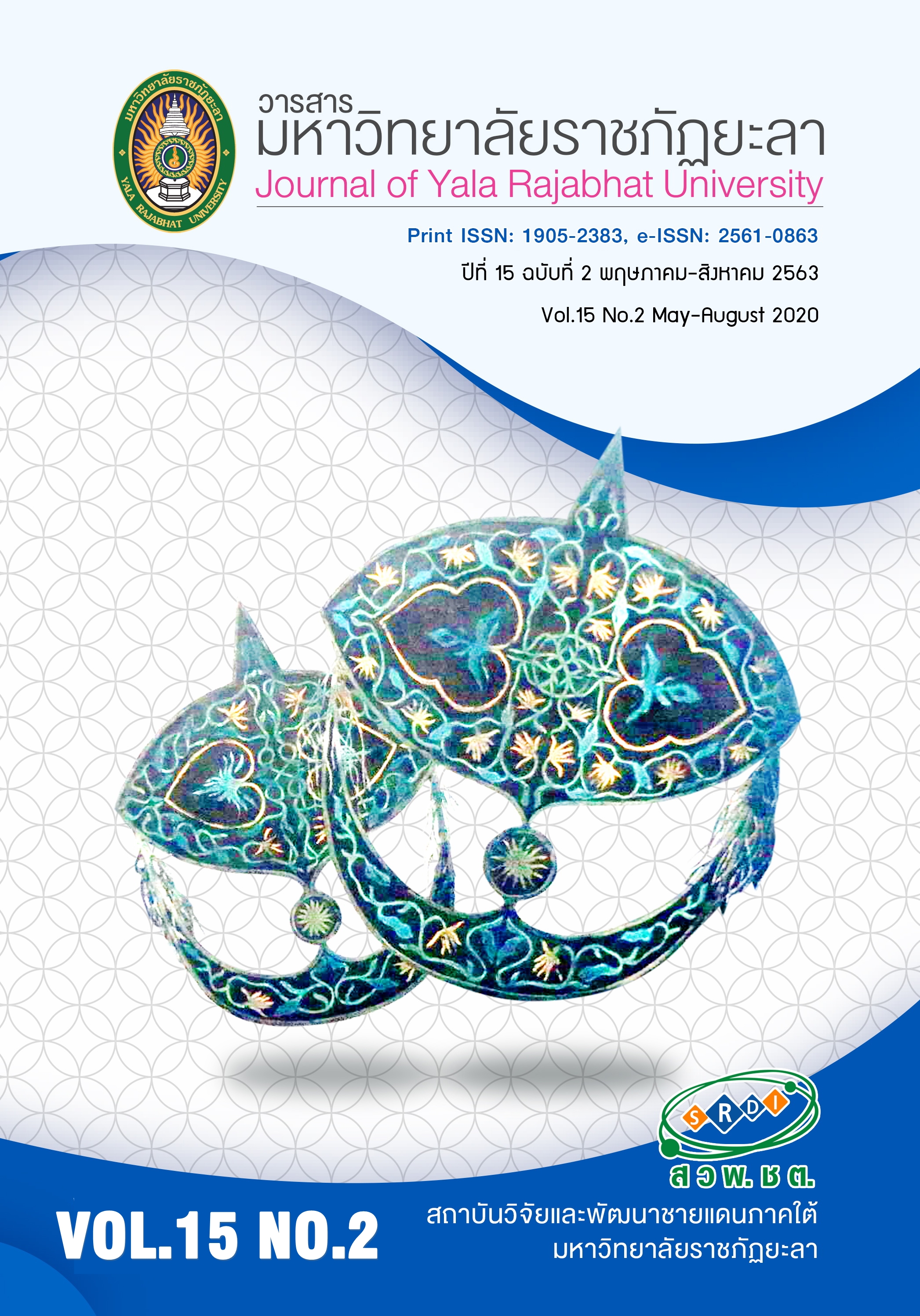โปรแกรมเพิ่มความสามารถด้านการบริหารจัดการของสมองด้วยทฤษฎีการจำแนกวัตถุประสงค์ทางการศึกษาของมาร์ซาโนในเด็กนักเรียนชั้นประถมศึกษาปีที่ 6
Main Article Content
บทคัดย่อ
การศึกษาครั้งนี้ มีวัตถุประสงค์เพื่อวิเคราะห์ความเหมาะสมโปรแกรมเพิ่มความสามารถด้านการบริหารจัดการของสมองด้วยทฤษฎีการจำแนกวัตถุประสงค์ทางการศึกษาของมาร์ซาโนในเด็กนักเรียนชั้นประถมศึกษาปีที่ 6 และเพื่อนำโปรแกรมเพิ่มความสามารถด้านการบริหารจัดการของสมองด้วยทฤษฎีการจำแนกวัตถุประสงค์ทางการศึกษาของมาร์ซาโนที่พัฒนาขึ้นไปใช้กับนักเรียนชั้นประถมศึกษาปีที่ 6 การศึกษาครั้งนี้เป็นการวิจัยเชิงปริมาณเพื่อประเมินการความเหมาะสมของโปรแกรมฯ โดยผู้เชี่ยวชาญจำนวน 2 คน และผู้ใช้งานที่เป็นเด็กนักเรียนชั้นประถมศึกษาปีที่ 6 จำนวน 5 คน การวิเคราะห์ข้อมูลเป็นการหาค่าเฉลี่ยความเหมาะสมของโปรแกรมฯ การศึกษาพบว่า ระดับคุณภาพของการพัฒนาโปรแกรมเพิ่มความสามารถด้านการบริหารจัดการของสมองด้วยทฤษฎีการจำแนกวัตถุประสงค์ทางการศึกษาของมาร์ซาโนในเด็กนักเรียนชั้นประถมศึกษาปีที่ 6 โดยภาพรวมของโปรแกรมมีความเหมาะสมมากถึงมากที่สุด
Article Details
บทความ ข้อมูล เนื้อหา รูปภาพ ฯลฯ ที่ได้รับการเผยแพร่ในวารสารมหาวิทยาลัยราชภัฏยะลานี้ ถือเป็นลิขสิทธิ์ของวารสารมหาวิทยาลัยราชภัฏยะลา หากบุคคลหรือหน่วยงานใดต้องการนำทั้งหมดหรือส่วนหนึ่งส่วนใดไปเผยแพร่ต่อหรือกระทำการใดๆ จะต้องได้รับอนุญาตเป็นลายลักษณ์อักษรจากวารสารมหาวิทยาลัยราชภัฏยะลาก่อนเท่านั้น
References
Anderson, P. (2002). Assessment and development of executive functioning (EF) in childhood. Child Neuropsychology, 8(2), 71-82.
Anderson, V. (2001). Assessing executive functions in children: biological, psychological, and developmental considerations. Pediatric Rehabilitation, 4(3), 119-136.
Anderson, V., Anderson, P., Northam, E., Jacobs, R. & Catroppa, C. (2001). Development of executive functions through late childhood and adolescence in an Australian sample. Developmental Neuropsychology, 20(1), 385-406.
Chan, R., Shum, D., Toulopoulou, T. & Chen, E. (2008). Assessment of executive functions: Review of instruments and identification of critical issues. Annual Review of Neuroscience, 23(2), 201-216.
Davidson, M. C., Arnso, D., Anderson, L. C., & Diamond, A. (2006). Development of cognitive control and executive functions from 4-13 years: Evidence from manipulations of memory, inhibition, and task switching. Neuropsychologia, 44(1), 2037-2078.
Dawson, P., & Guare, R. (2010). Executive skills in children and adolescents: A practical guide to assessment and intervention. (2nd ed.). New York: Guilford Press.
De Luca, C. R. & Leventer, R. J. (2008). Developmental trajectories of executive functions across the lifespan. In Anderson, P., Anderson, & V., Jacobs, R. Executive functions and the frontal lobes: a lifespan perspective, 3-21. Washington, DC: Taylor & Francis.
Diamond, A. & Lee, K. (2011). Interventions shown to aid executive function development in children 4 to 12 years old. Science, 333(1), 959-964.
Diamond, A., & Taylor, C. (1996). Development of an aspect of executive control: Development of the abilities to remember what I said and to “Do as I say, not as I do.”. Developmental Psychobiology, 29(1), 315-334.
Duncan, j. (2001). An adaptive coding model of neural function in prefrontal cortex, Nature Reviews Neuroscience, 820-829. London: Macmillan Magazines.
Elliott, R. (2003). Executive functions and their disorders. British Medical Bulletin, 1(65), 49-59.
Gardner, H. (1993). Multiple intelligences: The theory in practice. New York: Basic Books.
Garon, N., Bryson, S. E., & Smith, I. M. (2008). Executive function in preschoolers: A review using an integrative framework. Psychological Bulletin, 134(1), 31-60.
Gilbert, S. J., & Burgess, P. W. (2008). Executive function. Current Biology, 18(1), 110-114.
Johnson, R. B., & Christensen, L. B. (2004). Educational Research: Quantitative, Qualitative, and Mixed Approaches. Boston. MA: Allyn and Bacon.
Junwandee, K., Gumjadphai, S. & Kunpaibutr, T. (2018). The development of learning activities on principles of computer project work of information and communication technology subject for mathayom suksa 3 using ADDIE MODEL integrated with backward design. Journual of Curriclum and Instruction Sakon Nakhon Rajabhat University, 10(27), 125-134. (in Thai)
Marzano, R. J. (2001). Designing a New Taxonomy of Educational Objectives. Thousand Oaks. CA: Corwin Press.
Marzano, R. J. & Brown J. L. (2007). The art and science of teaching. Alexandria, VA: ASCD.
Miller, E. & Cohen, J. (2001). An integrative theory of prefrontal cortex function. Annual Review of Neuroscience, 24(1), 167-202.
Monsell, S. (2003). Task switching. TRENDS in Cognitive Sciences, 7(3), 134-140.
Norman, D., & Shallice, T. (1986). Attention to action: Willed and automatic control of behavior. In Davidson, R., Schwartz, R. G., & Shapiro, D. (Eds.), Consciousness and self-regulation: Advances in research and theory, 1-18. New York: Plenum Press.
Piaget, J. (1962). Play, dreams and imitation in childhood. New York: Norton.
Pongsakornnaruwong, M. (2013). The development of instructional model based on constructivist theory to enhance knowledge construction abilities of industrial vocational students (Doctoral dissertation). Retrieved from http://www.educ.su.ac.th/. (in Thai)
Ruangdaraganon, N. (2008). Texts of developmental and child behavior. Bangkok: Holistic Publishing. (in Thai)
Smilansky, S. (1968). The effects of sociodramatic play on disadvantaged preschool children. New York, NY: John Wiley & Sons.

